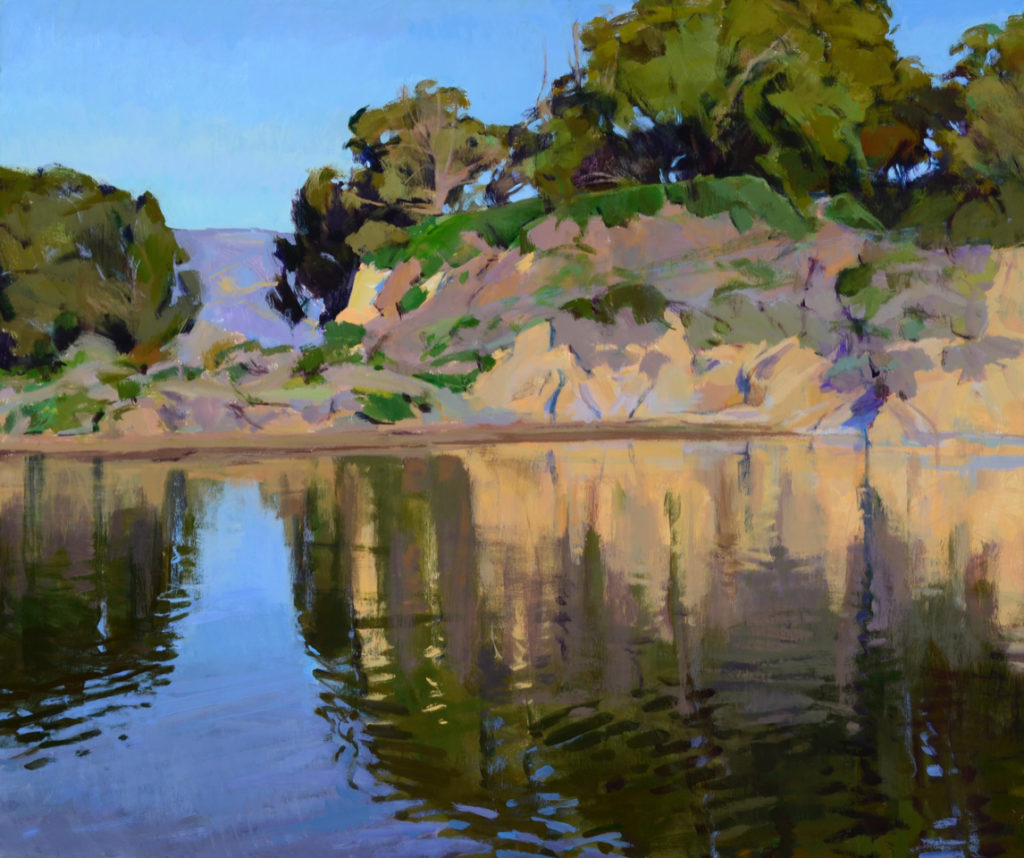Starting college at the University of Chicago, Marcia Burtt graduated from UC Berkeley and earned an MA in art from the University of Montana. Fine Art Today had the opportunity to ask Burtt about her style of contemporary landscape paintings and her chosen medium.
Fine Art Today: What’s a common question you hear about your contemporary landscape paintings?
Marcia Burtt: I’m often asked how a painter can find her own style.
To me, style is simply what results as we painters try to show what we think is most interesting or beautiful about what we see. It’s also the handwriting that develops as we use the medium we find most comfortable for our purposes.
Style is just who we are when we’re working!
It’s not something self-consciously developed to make our work look interesting or to make our paintings different from anyone else’s.
The same is true of brushwork, which is nothing more than the evidence on canvas of what we’re trying to do.
Why do you paint in acrylic? Do you work outdoors or mainly in the studio?
Unless I’m creating a 12-foot painting for hospital installation, I paint almost entirely outdoors. Spending hours on location intently observing the natural world is a kind of meditation. It allows my eyes to unpeel like an onion, so that everything becomes beautiful.
Acrylic is seen by many as a medium that’s hard to manage on location. For me it’s the road to the meditative process I experience as I work outside.
I love the freedom of jumping right in without a plan, drawing, underpainting, or even a thumbnail. That way the entire painting process is a joy.
I absolutely need a medium that lets me revise when I change my mind!
Acrylic is not only opaque and quick-drying, but it cannot be lifted or dissolved by subsequent layers. If I don’t like the stroke I just put on, I can use a damp rag to remove it immediately.
In essence, it’s oil painting without the waiting. The colors are just as rich, and I can mix and apply them exactly the same way. Yet it’s easy to scumble one color over another to create a pointillist effect or to revise the edge of a grove of trees without getting the sky color dirty.
When the weather changes, I can too. As the sun and shadows move, I can follow them. When the tide and waves go in and out, I can paint over and over, searching for what works with the rest of the painting.
When my drawing isn’t accurate, I can paint the negative shapes to correct it, working back and forth from one shape to another in a lengthy painterly duet.
Please tell us about your paintings of water.
Whether calm and reflective, ruffled, or ocean rollers, I love painting water. Maybe because I enjoy waiting for just the right moment to put each brushstroke on the canvas, an acutely meditative practice.
“Colors of a Grey Day” was painted during an intense week when I worked all day every day along the coast of Laguna Beach. The overcast sky and tide that came gently in and gently out kept the scene from changing much. Soft blues, greens, and bronzes flowed off my brush onto the canvas. This was one of the easiest paintings I’ve ever done, and one I’m still satisfied with.

“Ruffled Water, High Tide” took many sessions at the same time of day over the course of more than a week. Sunny weather meant the shadows changed during the day. Light wind caused the water to ripple, and ripples don’t sit still!
But above all, because I didn’t draw beforehand, I spent an enormous amount of time revising so that features I became aware of as I worked would weave together to satisfy my compositional sense.
The arc of the clifftop with tree shadows on top of it is intersected on the right by a patch of sky as it works its way down through the trees, and that line is picked up by a shadow in the cliff, continuing to a vertical as it drops into the water.
That arc intersecting the winding slender vertical seemed absolutely necessary as it echoed the large vertical blue column of sky and water on the left.
Because it’s acrylic, no one but us knows there are dozens of versions under what we see.

> Click here to subscribe to Fine Art Connoisseur magazine, so you never miss an issue








The work of, Marcia Burt, is beautiful. Thank you for this article. I, also, work in acrylic. Therefore, I especially like the interviews of acrylic artists. I am a 67 year old beginner but am learning more everyday.
Anyway, this article has been inspiring. Thank you for offering this to us.
Have always loved Marcia’s work. She own’s water!!